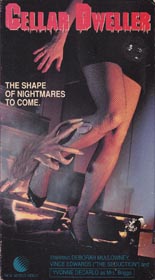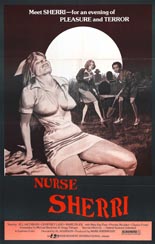
 Four years before Barbara Hershey infamously got raped by a ghost in The Entity, Al Adamson had it done (poorly) to Nurse Sherri, his attempt at cashing in on the then-popular possession-pic craze.
Four years before Barbara Hershey infamously got raped by a ghost in The Entity, Al Adamson had it done (poorly) to Nurse Sherri, his attempt at cashing in on the then-popular possession-pic craze.
Sherri (Jill Jacobson, The Jigsaw Murders) has the unfortunate position of working the ER when a cult leader (Bill Roy, Black Samurai) with occult powers dies on the table, and passes his soul into her. That night, as she lay on her bed, a barely animated patch of green dots and squiggly lines enters her room, parts her legs and goes to town.
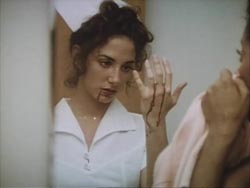 From then on, Sherri’s literally not herself, speaking in a deep register reminiscent of third-rung Looney Tunes characters and slaughtering those responsible for her possessor’s death. His disembodied, superimposed head occasionally pops up to laugh manically at others. Meanwhile, all her fellow RNs can do is think of sex — and acting on it, as if they’re in one of Roger Corman’s Nurses movies.
From then on, Sherri’s literally not herself, speaking in a deep register reminiscent of third-rung Looney Tunes characters and slaughtering those responsible for her possessor’s death. His disembodied, superimposed head occasionally pops up to laugh manically at others. Meanwhile, all her fellow RNs can do is think of sex — and acting on it, as if they’re in one of Roger Corman’s Nurses movies.
Adamson’s reputation is that of an inept, bottom-of-barrel filmmaker à la Ed Wood — a position not quite accurate if one considers the entirety of his work, but wholly warranted if one were to judge him on Nurse Sherri alone. It’s an ambling, scattered-focus potboiler made for all the wrong reasons, and given that Adamson’s usual starlet, real-life leading lady Regina Carrol, is absent from the cast, one can’t help but wonder if he just couldn’t harness any passion this time. Viewers who are able to might want to watch both cuts; the theatrical one plays up the horror, while the alternate amps up the copulation. —Rod Lott


 In a fairer world,
In a fairer world, 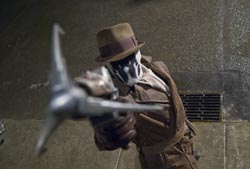
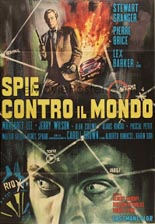
 Anthology films largely reside in the realm of horror, only occasionally landing in comedy and science fiction. But spy movies? It happened — in Italy, of course — in
Anthology films largely reside in the realm of horror, only occasionally landing in comedy and science fiction. But spy movies? It happened — in Italy, of course — in 
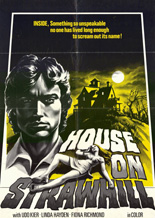
 After nailing down a cool half-mil on his debut, novelist Paul Martin (Udo Kier,
After nailing down a cool half-mil on his debut, novelist Paul Martin (Udo Kier, 
